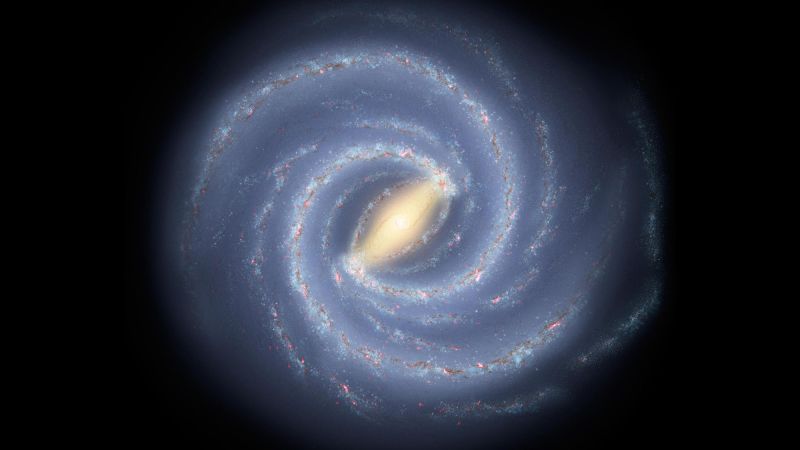
In a groundbreaking revelation, astronomers have recalibrated the cosmic clock predicting the collision between the Milky Way and the Andromeda galaxy. Originally anticipated to occur in approximately 4.5 billion years, new research published in Nature Astronomy suggests that this celestial event, often referred to as “Milkomeda,” is less imminent than previously thought.
The study indicates that the probability of a direct collision between these two massive galaxies is significantly lower than earlier estimates. Instead of a certain clash, there’s now only about a 2% chance of collision within the next 4 to 5 billion years, and a 50% chance over the next 10 billion years.
Revisiting Cosmic Predictions
For over a century, the collision of the Milky Way and Andromeda has been a topic of keen interest among astronomers. The two galaxies, separated by about 2.5 million light-years, are currently moving towards each other at an impressive speed of 223,694 miles per hour (100 kilometers per second). However, the dynamics of this impending encounter are more complex than a straightforward collision course.
The Local Group, which includes our Milky Way, Andromeda, and approximately 100 smaller galaxies, plays a crucial role in this cosmic ballet. Researchers have now accounted for the gravitational influences of significant neighbors like the Large Magellanic Cloud (LMC) and the Triangulum galaxy (M33).
Simulating Galactic Interactions
By incorporating data from the Hubble and Gaia space telescopes, the team conducted 100,000 simulations to explore potential outcomes. These simulations considered 22 different variables, including uncertainties in the positions, velocities, and masses of the Local Group galaxies.
“We ran many thousands of simulations, which allowed us to account for all the observational uncertainties,” said Dr. Till Sawala, lead author and astronomer at the University of Helsinki.
The gravitational pull from the LMC and M33 introduces significant deviations in the Milky Way’s motion, reducing the likelihood of a merger with Andromeda. As Dr. Sawala elaborated, “The LMC pulls the Milky Way off the orbital plane and away from Andromeda. It doesn’t mean that the LMC will save us from that merger, but it makes it a bit less likely.”
Potential Outcomes of a Galactic Merger
Should a collision occur, the consequences would be monumental. The merging of the Milky Way and Andromeda would likely obliterate their spiral structures, forming an elongated galaxy. Such cosmic events are known to trigger “cosmic fireworks,” where gas driven to the center of the merger remnant feeds a central black hole, emitting vast amounts of radiation.
“Until now we thought this was the fate that awaited our Milky Way galaxy,” said Carlos Frenk, a coauthor of the study and professor at Durham University. “We now know that there is a very good chance that we may avoid that scary destiny.”
In many of the simulations, the galaxies initially bypassed each other, only to eventually lose orbital energy and merge. This process could lead to a strong starburst phase, followed by intense radiation from exploding stars and an active supermassive black hole, ultimately resulting in a featureless elliptical galaxy.
Implications for Earth and the Solar System
While the potential merger of galaxies may seem daunting, the fate of our own solar system might be more directly influenced by the life cycle of the sun. In about 5 billion years, the sun will transform into a red giant, potentially engulfing Earth.
“The short answer is that the end of the sun is far worse for our planet than the collision with Andromeda,” Sawala noted. “Collisions between stars or planets are extremely rare during galaxy mergers.”
Although the study did not model a detailed merger between the Milky Way and the LMC, it confirmed a “virtual certainty” of such an event within the next 2 billion years. This merger would not destroy the Milky Way but could significantly alter its structure, particularly affecting the central supermassive black hole and the galactic halo.
Looking Ahead: Future Observations
The study highlights the importance of accounting for uncertainties in cosmic predictions. As more data becomes available from the Gaia space telescope in 2026, researchers hope to refine their understanding of the dynamics between these galactic giants.
“This really gives us the whole picture of what could happen in the future,” said Scott Lucchini, a postdoctoral fellow at the Center for Astrophysics, Harvard & Smithsonian.
While the ultimate fate of the Milky Way remains uncertain, these findings offer a more nuanced understanding of our place in the universe and the cosmic forces at play.





